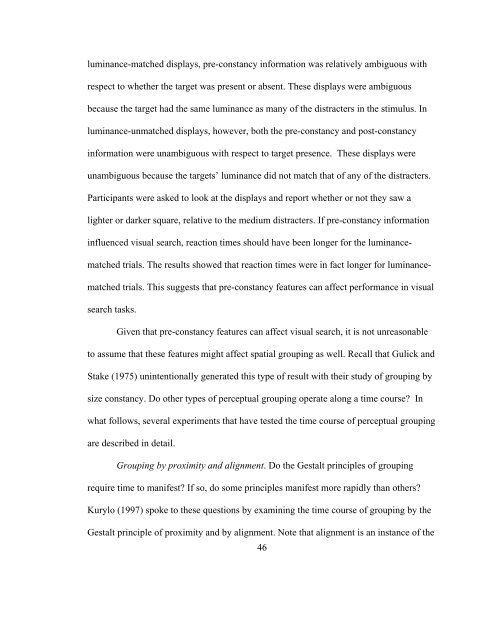The Use of Iambic Pentameter in the
The Use of Iambic Pentameter in the
The Use of Iambic Pentameter in the
You also want an ePaper? Increase the reach of your titles
YUMPU automatically turns print PDFs into web optimized ePapers that Google loves.
lum<strong>in</strong>ance-matched displays, pre-constancy <strong>in</strong>formation was relatively ambiguous with<br />
respect to whe<strong>the</strong>r <strong>the</strong> target was present or absent. <strong>The</strong>se displays were ambiguous<br />
because <strong>the</strong> target had <strong>the</strong> same lum<strong>in</strong>ance as many <strong>of</strong> <strong>the</strong> distracters <strong>in</strong> <strong>the</strong> stimulus. In<br />
lum<strong>in</strong>ance-unmatched displays, however, both <strong>the</strong> pre-constancy and post-constancy<br />
<strong>in</strong>formation were unambiguous with respect to target presence. <strong>The</strong>se displays were<br />
unambiguous because <strong>the</strong> targets’ lum<strong>in</strong>ance did not match that <strong>of</strong> any <strong>of</strong> <strong>the</strong> distracters.<br />
Participants were asked to look at <strong>the</strong> displays and report whe<strong>the</strong>r or not <strong>the</strong>y saw a<br />
lighter or darker square, relative to <strong>the</strong> medium distracters. If pre-constancy <strong>in</strong>formation<br />
<strong>in</strong>fluenced visual search, reaction times should have been longer for <strong>the</strong> lum<strong>in</strong>ance-<br />
matched trials. <strong>The</strong> results showed that reaction times were <strong>in</strong> fact longer for lum<strong>in</strong>ance-<br />
matched trials. This suggests that pre-constancy features can affect performance <strong>in</strong> visual<br />
search tasks.<br />
Given that pre-constancy features can affect visual search, it is not unreasonable<br />
to assume that <strong>the</strong>se features might affect spatial group<strong>in</strong>g as well. Recall that Gulick and<br />
Stake (1975) un<strong>in</strong>tentionally generated this type <strong>of</strong> result with <strong>the</strong>ir study <strong>of</strong> group<strong>in</strong>g by<br />
size constancy. Do o<strong>the</strong>r types <strong>of</strong> perceptual group<strong>in</strong>g operate along a time course? In<br />
what follows, several experiments that have tested <strong>the</strong> time course <strong>of</strong> perceptual group<strong>in</strong>g<br />
are described <strong>in</strong> detail.<br />
Group<strong>in</strong>g by proximity and alignment. Do <strong>the</strong> Gestalt pr<strong>in</strong>ciples <strong>of</strong> group<strong>in</strong>g<br />
require time to manifest? If so, do some pr<strong>in</strong>ciples manifest more rapidly than o<strong>the</strong>rs?<br />
Kurylo (1997) spoke to <strong>the</strong>se questions by exam<strong>in</strong><strong>in</strong>g <strong>the</strong> time course <strong>of</strong> group<strong>in</strong>g by <strong>the</strong><br />
Gestalt pr<strong>in</strong>ciple <strong>of</strong> proximity and by alignment. Note that alignment is an <strong>in</strong>stance <strong>of</strong> <strong>the</strong><br />
46

















